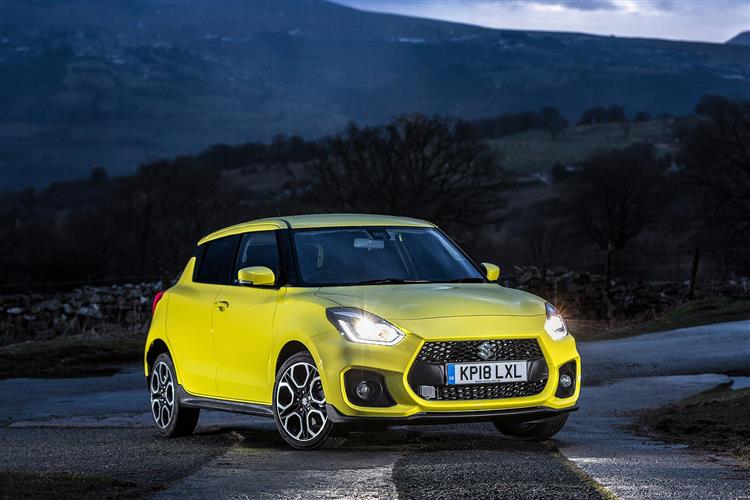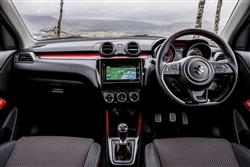MORE QUESTIONS OF SPORT. (some text hidden) --NONE--
By Jonathan Crouch
Introductionword count: 93
The Suzuki Swift Sport has long been a car embraced by serious drivers who know a great handling hot hatch when they see it. Though not especially powerful, it's agile, responsive and brilliant fun for not a lot of money. Few potential buyers know this, so the idea with this third generation model back in 2017 was to widen its appeal with a smarter interior, lower running costs, a little more grunt and even sharper handling. Let's check the original version of this third generation Swift Sport design out as a used buy.
Modelsword count: 7
5dr hatch (Petrol - 1.4 Boosterjet 140PS)
Historyword count: 252
The Suzuki Swift Sport has always offered buyers a simple, light hot hatch formula. This third generation version, the first to be turbocharged, aimed to do that with a little more sophistication. The two previous versions of this contender, launched respectively in 2006 and 2012, both used a high-revving normally aspirated 1.6-litre engine that was central to their appeal. So the decision in 2017 to finally replace that with a 1.4-litre turbo unit was one that loyal buyers had to get used to, particularly as the new Boosterjet powerplant had a very similar output to the outgoing 1.6, the 1.4 rated at 140PS. At launch, the media questioned Suzuki's decision to price this MK3 model so closely to the much pokier Fiesta ST and other models of that ilk. In response, the Japanese brand was keen to reference the fact that this car was from launch the lightest - and therefore potentially the most agile - car in its class. And that the power it offered was more usable because the Boosterjet engine made it available low down in the rev range. Suzuki also made the point that this MK3 Swift Sport could offer a class-leadingly impressive equipment specification, including more standard camera-driven safety kit than any other model in the segment of this period could offer. The original version of this MK3 Swift Sport sold until Spring 2020, when it was replaced by a Hybrid version. It's the 2017-2020-era non-hybrid version of this MK3 model though, that we look at here.
What You Getword count: 441
This car doesn't only show some other affordable small hot hatches how they should drive. It also, for us, offers a good template on how they should look. Muscular shoulders, blacked-out A-pillars and what Suzuki calls 'under-spoilers' all-round deliver a potently understated level of pavement presence but also a demeanour that's assertive enough to suggest you might be in for a bit of fun at the wheel. This MK3 Swift Sport is 50mm longer than a standard Swift model and sits 15mm lower to the ground than the previous generation version did. A little disappointingly, unlike that old MK2 model, there was no three-door body style option offered, but Suzuki sought to retain a three-door-like look by hiding the rear door handles in the trailing edge of the C-pillar. Of course, as usual, what's more important is the stuff you can't see, namely this MK3 model's stiff, sophisticated 'TECT' platform, designed around what Suzuki calls 'Total Effective Control Technology'. This uses lots of high strength steel to make the structure very strong but also low in weight, which is the main reason why this Swift weighs so little, even by relatively light class standards. You feel this model's light weight when you slam the driver's door shut, which isn't ideal, but otherwise, by supermini standards, the cabin feels quite nice, providing you're not expecting premium-quality fittings and acres of slush-moulded soft-touch plastic: you're not paying for that kind of thing here and you don't get it. What you do get is just enough interior differentiation to make you feel you're in a serious hot hatch. The grippy branded sports bucket seats are probably the highlight, proving to be supportive and surprisingly comfortable, providing your frame is narrow enough to fit into them. There's also a set of aluminium pedals, a chrome-accented gear knob with a red-stitched gaitor and emotive red flashings on the fascia and the centre stack. This car remains one of the more compact models in the supermini hot hatch segment when it comes to rear seat space. Some might even find it a touch claustrophobic in the back. Still, thanks to that lengthened wheelbase and some extra room liberated from the engine compartment, there is now marginally more legroom on offer than there was in the old MK2 model. Out back in the boot, the light tailgate raises to reveal a cargo area space that offers 25% more space than was available in the previous generation model. The 265-litre capacity isn't anything like enough to threaten the segment class leaders in this regard but it was at least enough to get this Suzuki back on a competitive footing.
To see the full road test text contact us on 0330 0020 227
Pictures (high res disabled)

.jpg)
|
.jpg)
|
.jpg)
| |||
.jpg)
|
.jpg)
|
.jpg)
| |||
.jpg)
|

|
Scoring (subset of scores)
Category: Sporting Cars
| Performance | |
| Handling | |
| Comfort | |
| Space | |
| Styling, Build, Value, Equipment, Depreciation, Handling, Insurance and Total scores are available with our full data feed. | |



